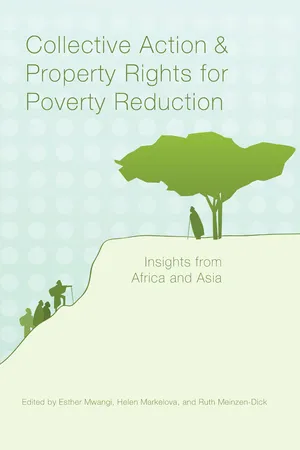
Collective Action and Property Rights for Poverty Reduction
Insights from Africa and Asia
- 448 pages
- English
- PDF
- Available on iOS & Android
Collective Action and Property Rights for Poverty Reduction
Insights from Africa and Asia
About this book
To improve their well-being, the poor in developing countries have used both collective action through formal and informal groups and property rights to natural resources. Collective Action and Property Rights for Poverty Reduction: Insights from Africa and Asia examines how these two types of institutions, separately and together, influence quality of life and how they can be strengthened to improve the livelihoods of the rural poor.
The product of a global research study by the Systemwide Program on Collective Action and Property Rights (CAPRi) of the Consultative Group on International Agricultural Research, this book draws on case studies from East Africa and South and Southeast Asia to investigate how collective action and property rights have contributed to poverty reduction. The book extends the analysis of these institutions beyond their frequently studied role in natural resource management by also examining how they can reduce vulnerability to different types of shocks.
Essays in the volume identify opportunities and risks present in the institutions of collective action and property rights. For example, property rights to natural resources can offer a variety of advantages, providing individuals and groups not only with benefits and incomes but also with assets that can counter the negative effects of shocks such as drought, and can make collective action easier. The authors also demonstrate that collective action has the potential to reduce poverty if it includes more vulnerable groups such as women, ethnic minorities, and the very poor. Preventing exclusion of these often-marginalized groups and guaranteeing genuinely inclusive collective action might require special rules and policies. Another danger to the poor is the capture of property rights by elites, which can be the result of privatization and decentralization policies; case studies and analysis identify actions to prevent such elite capture.
Frequently asked questions
- Essential is ideal for learners and professionals who enjoy exploring a wide range of subjects. Access the Essential Library with 800,000+ trusted titles and best-sellers across business, personal growth, and the humanities. Includes unlimited reading time and Standard Read Aloud voice.
- Complete: Perfect for advanced learners and researchers needing full, unrestricted access. Unlock 1.4M+ books across hundreds of subjects, including academic and specialized titles. The Complete Plan also includes advanced features like Premium Read Aloud and Research Assistant.
Please note we cannot support devices running on iOS 13 and Android 7 or earlier. Learn more about using the app.
Information
Table of contents
- Cover
- Title Page
- Copyright Page
- Table of Contents
- List of Figures
- List of Tables
- List of Boxes
- Foreword
- Acknowledgments
- Acronyms and Abbreviations
- Part I: Introduction and Conceptual Framework
- Part II: Risk Management and Market Access
- Part III: Natural Resource Management
- Part IV: Synthesis and Conclusions
- Contributors
- Index